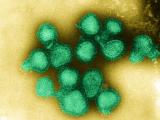Feb 4, 2011 (CIDRAP News) – The United States saw increased influenza activity last week, as 30 states cited widespread flu and six pediatric deaths related to the illness were reported, the Centers for Disease Control and Prevention (CDC) announced today.
The CDC also said another case of a person contracting a novel influenza A/H3N2 virus from pigs was reported, marking the seventh such instance since the beginning of last year. The patient was not seriously ill and has fully recovered, the agency said.
US flu activity often peaks in February, and the latest weekly flu update seemed to fit that pattern. The report says that 32.9% of the respiratory samples tested by the national network of surveillance labs were positive for flu, up from about 30% last week.
Of the 2,044 positive specimens, 81.2% were influenza A and 18.2% were influenza B, which differed only slightly from the previous week. Forty-three percent of the type A isolates were H3 viruses and 25.3% were 2009 H1N1 strains, while the rest were not subtyped. That compared with 42% H3 and 23.9% H1N1 the previous week.
Influenza-like illness (ILI) accounted for 4.0% of visits to sentinel healthcare providers last week, up from 3.6% the week before and above the national baseline of 2.5%, the CDC reported. Seventeen states cited high ILI activity, and three states had moderate activity, as compared with nine and three states, respectively, the week before.
As for the geographic extent of flu, 30 states reported widespread activity for the week, five more than the previous week. Sixteen states had regional activity, while four states and Washington, DC, had local activity.
The share of deaths attributed to pneumonia and influenza rose to 8.5% last week, exceeding the previous week's 7.5% and the epidemic threshold of 7.9%, the CDC reported.
The six flu-related deaths in children reported last week bring the total for this season to 19. Of the 6 fatal cases, 4 were attributed to type B viruses, 1 to H3N2, and 1 to 2009 H1N1. The latter was the first pediatric death blamed on the H1N1 strain this season.
The human case of swine-origin H3N2 influenza was reported by Pennsylvania officials, the CDC said. The patient reported having contact with pigs in the week before symptoms appeared on Sep 6, 2010. Initial testing indicated a seasonal H3N2 virus, and the sample was submitted to the CDC. Efforts to culture the virus failed, but polymerase chain reaction eventually showed it to be a swine-origin H3N2 strain.
The CDC said there was no evidence of human-to-human transmission of the virus. Six other swine-origin H3N2 cases have been identified in the United States in the past 13 months, including one other case in Pennsylvania last fall.
"No epidemiologic links between this case and any of the other cases of swine-origin H3N2 infection have been identified and the viruses from all seven cases have genetic differences indicating different sources of infection," the report said.
See also:
Feb 4 CDC flu update




















